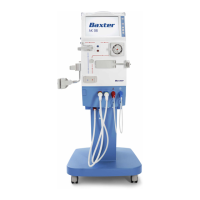HCEN12630 Revision 07.2015
Program version 1.xx
AK 98™ Dialysis Machine - Technical description 95
The priming detector detects if there is blood in the venous blood line. If no blood is
detected, it is not possible to start the treatment.
The priming detector is a two-channel device. One of the channels is connected to the
control system and the other channel is connected to the protective system.
The purpose of the priming detector is to facilitate priming by suppressing certain
alarms when no blood is in the venous line.
The control system outputs a pulse train to the transmitting side (an LED) of the
priming detector head.
When blood is detected for more than 20 seconds, the control system and the
protective system disconnect the priming detector function and keep the AK 98 dialysis
machine in blood mode until the end of the treatment, i.e. when Time = 0:00 is
confirmed. Confirmation is done by confirming the attention
596 Treatment time expired
To continue press Confirm.
.
When the monitor is out of blood mode, it is possible to leave treatment mode.
The blood is transported back to the patient via the venous line clamp. The clamp is
normally open. But in the event of an alarm from the air detector or the venous
pressure transducer, the line clamp clamps the blood line and stops the blood flow
(except during a high pressure alarm).
3.4.3.3 BPM - blood pressure module (option)
The BPM monitor is a measuring device that can issue attentions and alarms but the
alarms will not interfere with the treatment.
The intended use for the BPM is to measure the patient’s blood pressure and to
activate an alarm if the patient’s blood pressure drops below the alarm limit set by the
operator. This will give the nurses the possibility to take measures before the patient
suffers the ill effects of hypotension (low blood pressure).
The BPM module includes the following components: air pump, bleed valve, dump
valve, pressure transducers (control and protective), and microprocessor board. The
module includes control and protective systems.
The control system measures the pressure and pulse wave to calculate the systolic,
diastolic, mean blood pressure and pulse rate. The air pump, dump, and bleed valves
are controlled by this system as well as externally.
The protective system supervises the maximum pressure and inflating time. The
maximum pressure is 320 ± 10 mmHg, and the maximum inflating time is 180
seconds. When these values exceed specified limits, the dump and bleed valves are
opened and the air pump is stopped by the protective system.
A self-calibration/auto zero function is included in the module, which means that the
offset for the pressure transducers is calibrated/adjusted each time the module is
turned on.
The BPM measures and calculates non-invasive blood pressure by using the
oscillometric method. This method uses the pulsations that occur in the artery of the
arm when it is restricted by the inflated cuff. The noise or oscillation originates from the
fact that when the cuff restricts the vessel, the flow in the vessel becomes turbulent,
instead of laminar. The pulsation causes the pressure in the cuff to oscillate, which the
pressure transducer in the BPM module measures.

